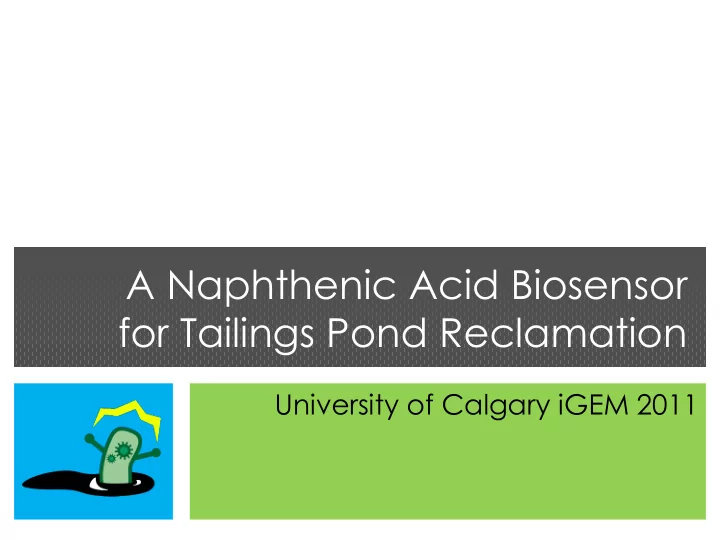

A Naphthenic Acid Biosensor for Tailings Pond Reclamation University of Calgary iGEM 2011
Oil Sands Extraction + hot water Open pit + chemical agents mining (NaOH) Crusher Slurry mixture Separation Extraction Froth plant Water Sand Tailings ponds Gieg L. (2011).
Naphthenic Acids (NAs) • Recalcitrant carboxylic acids • C n H 2 n + z O 2 Adapted from Whitby C. (2010).
You’re Killing Me! NAs in tailings ponds are highly toxic to a variety of organisms 80 75 70 60 50 50 LC50 (mg/L) 50 96-hour 40 60-day 30 20 14 11 10 2 0 Rutulis frisii kutum Acipenser gueldenstaedi Rutulis rutulis caspicus (sturgeon) (adult kutum) (roach) Compiled from Dokholyan VK., Magomedov AK. (1983).
Social Implications of NAs Concern about Oil Assessment Sands Toxins technologies need to Increasing social Government response mature alongside concern about of increasingly strict Stricter Legislation process technologies industrial impact on legislation to meet government the environment standards Improved Detection Technologies
What Already Exists? Gas Chromatography-Mass Spectrometry (GC-MS) Fourier Transform Infrared Spectroscopy (FTIR) Roesler R. (2007). and ASU Knowledge Enterprise Development
Introducing… Pseudomonas putida Dunaliella tertiolecta Pseudomonas fluorescens Photos courtesy of Dennis Kunkel and the University of Tsukuba
The Vision Quantitative Output Tailings In Biosensing Organism Response
Building a Biosensor Naphthenic Acid Detector Reporter Chassis
The Search For a Promoter Biotinylation/Immunoprecipitation “Sensory Element Fishing” Candidate Gene Approach
Biotinylation Cyclohexane Biotinylated Biotin Pentanoic Acid Cyclohexane Pentanoic Acid
Biotinylation Streptavidin Bead
Precipitation
Precipitation
Confirming Biotinylation
Confirming Biotinylation Successful Biotinylation of Three Naphthenic Acids!
Pull-Down
The Search For a Promoter Biotinylation/Immunoprecipitation “Sensory Element Fishing” Candidate Gene Approach
Cooperative Degradation of NAs Del Rio et al. (2006).
Which Horse Should I Pick?
qRT-PCR Data Putative Enoyl-CoA Hydratase ( Pseudomonas fluorescens LD2 ) NA exposure regulates expression of fad-2/Enoyl CoA Hydratase
Up and Down… GFP RFP
Current Progress • Designed a novel protocol to identify small hydrophobic molecule interactors • Identified a possible NA-responsive gene
Building a Biosensor: Reporter lacZ
The CPR Pathway chlorophenol red β -GAL chlorophenol red- β -D- galactopyranoside galactose
β -Gal Cleaves CPRG BBa_I732901 IPTG lacZ Inducible Concentration of CPR formed 2.5 Concentration of CPR formed (mM) 2 1.5 1 0.5 0 0:00 0:28 0:57 1:26 1:55 2:24 2:52 3:21 3:50 4:19 Time (hrs:min)
Cyclic Voltammetry
Circuitry and Measurement
Circuitry and Measurement Change in Current ( Δ mA) 0.041 0.039 0.030 0 uM 100uM 1mM CPRG Degradation Can Be Detected Electrochemically With Our Construct!
Electrochemical Optimization • Optimized buffering systems • Cation co-factor inclusion • Plating technique refined Nanopure H 2 0 0.1 M CaCl 2
Building a Biosensor: Chassis
E. coli Growth Assay
Working with New Organisms • New Microalgae Protocols on Our Wiki – Transformation – Isolation of Chloroplasts – Isolation of DNA PEG H + H + H + H + H + Culture Agitation
Duneliella is Transformed! Bright field Gus stain Merge
Existing Tools Selectable Markers S K Strong Constitutive Promoter 35S CaMV Visual Qualitative Reporter
What Do We Need? Heat-Inducible Promoter (BBa_K640001) HspA70 Algae-Optimized Luciferase (BBa_K640000)
Bacterial Conjugation OriT Ori1600 Ori1600
Growth Assay Data Amp Chlor Kan LB E. coli (Amp Resistant) P. putida LD1 P. fluorescens LD2
Conjugation Results C = Calgary B = Berkeley E. coli Control C C C B B CTRL CTRL Yellow = Pseudomonas Growth
Quantitation (Calgary) (Berkeley)
The Final Construct
Prototype Circuit Diagram Corresponding Prototype
The Vision Quantitative Output Tailings In Biosensing Organism Electrochemical Detector
Market Analysis Component Price Per Unit ($) Units Cost (CAN $) Prototyping Board 13.70 1 13.70 Component Total Cost ($) Units Cost Per Unit ($) Box 9.90 1 9.90 Batteries and 2.64 2 5.28 LB Broth for Cultures 333.00 125 000 0.0027 Connectors Electrodes 200.00 100 2.00 Electrode Connectors 3.23US 1 3.24 Other Components 1.09US 3 3.27 Lab Technician Stipend 25.00/hr 200 0.13 Wires 18.06US/30.5m 25cm 0.15 Total Cost 2.13 Total Cost 35.54
Accomplishments • Designed a novel protocol to identify small hydrophobic molecule interactors • Identified a possible NA-responsive gene • Characterized a novel reporter function for the lacZ gene • Characterized a Pseudomonas-E. coli conjugation construct • Submitted parts and protocols for future work in microalgae and Pseudomonas • Conducted a market analysis
Outreach Bassano PATW Music Video Collaboration Report
Acknowledgements • Dr. Arcellana-Panlilio, • Dr. Moorhead Dr. Nygren, Dr. • Department of Cell Schryvers, Dr. Gieg, Biology and Anatomy Dr. Alcantara, Dr. • Department of Muench Electrical Engineering • Deirdre Lobb • Department of • Birss Lab Biomedical • Cobb Lab Engineering • Dr. Tung • Erin Brown
Our Sponsors
Collaboration Data
Reaction Mechanism EDAC + H 2 N – R H 2 N – R +
Human Practices Increasing social concern Government response of about industrial impact on increasingly strict the environment legislation Assessment technologies A market for a biosensor need to mature alongside that can efficiently detect process technologies to naphthenic acids in a meet government sample standards Use of synthetic biology in environmental monitoring paves the road for larger-scale uses in the industry (i.e. remediation) *Please see the U of C team Wiki for more information on current policy and standards*
Circuitry and Measurement CPRG Degradation Can Be Detected Electrochemically With Our Construct!
Recommend
More recommend